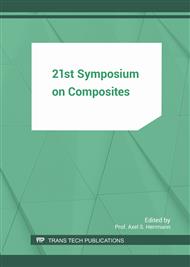p.25
p.31
p.38
p.46
p.54
p.62
p.70
p.74
p.82
Influence of the Chemical Functionalisation of Glass Fibre Surfaces on the Mechanical Properties of Continuous Fibre Reinforced Thermoplastics
Abstract:
Continuous fibre reinforcements in thermoplastic composites require an enhanced adhesion to the matrix component, in order to effectively divert external forces from the matrix. Therefore different silanes as adhesion promoters are used as a part of the sizing. They operate as a connector to the matrix component. These silanes affect the sliding properties of the sizing during the production of the glass filaments in a negative way, in which case the proportion of the adhesion promoter in the sizing must be kept at a low level in order to maintain the processing speed in the textile production process. With the immersion bath method, it was examined whether the treatment of the surface of textile fabric after the textile production process with a silane-containing aqueous solution could solve these problems. Different silane concentrations and solvents were considered. After drying the textiles were processed during a two-step pressing process directly into a multi-layer organic sheet with a textile-based polypropylene matrix. The successful layering of the adhesion promoter on the glass fibre surface was verified by Fourier transform infrared (FTIR) spectroscopy. With thermogravimetric analysis (TGA), the thermal resistance of the adhesion-promoting layer for the subsequent pressing process could be shown. In order to examine the influence of the layer on the fibre/matrix adhesion within the composites, the Young’s modulus and flexural modulus of the composite panels were determined. Impact experiments were made to measure the required penetration energy and the energy absorption capacity of the composite panels. An optimum for the amount of adhesion promoter could be found. Exceeding the optimum amount of adhesion promoter in the solution led to a decrease in the mechanical properties of the composite.
Info:
Periodical:
Pages:
54-61
Citation:
Online since:
July 2017
Price:
Сopyright:
© 2017 Trans Tech Publications Ltd. All Rights Reserved
Share:
Citation:


